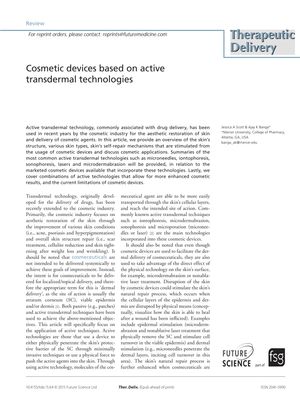Cosmetic Devices Based on Active Transdermal Technologies
September 2015
in “
Therapeutic Delivery
”

TLDR Active transdermal technologies in cosmetics help deliver skin treatments effectively, but their safety and effectiveness depend on skin type and treatment choice.
The 2015 document reviews the use of active transdermal technologies in the cosmetic industry for skin restoration and delivery of cosmetic agents. These technologies include microneedles, iontophoresis, sonophoresis, lasers, and microdermabrasion. The effectiveness of these devices is influenced by the molecule's size, physicochemical properties, and individual skin structure. The FDA classifies many of these devices as class I or II, with class II devices not requiring pre-market approval. Microneedles create micro-pores in the skin, iontophoresis uses electrical currents, sonophoresis employs ultrasound waves, and lasers are used for skin microporation. These devices are used to treat conditions like rosacea, acne, and photodamaged skin, and are available for both consumer and clinical use. The document highlights the importance of considering skin types to avoid adverse effects and notes that while ablative lasers are effective, they have significant side effects and recovery times, making nonablative lasers safer for darker skin types. Microdermabrasion is effective in stimulating collagen without damaging the skin barrier. The choice of technology should be based on skin type and condition severity, with ongoing developments expected to expand treatment options.


